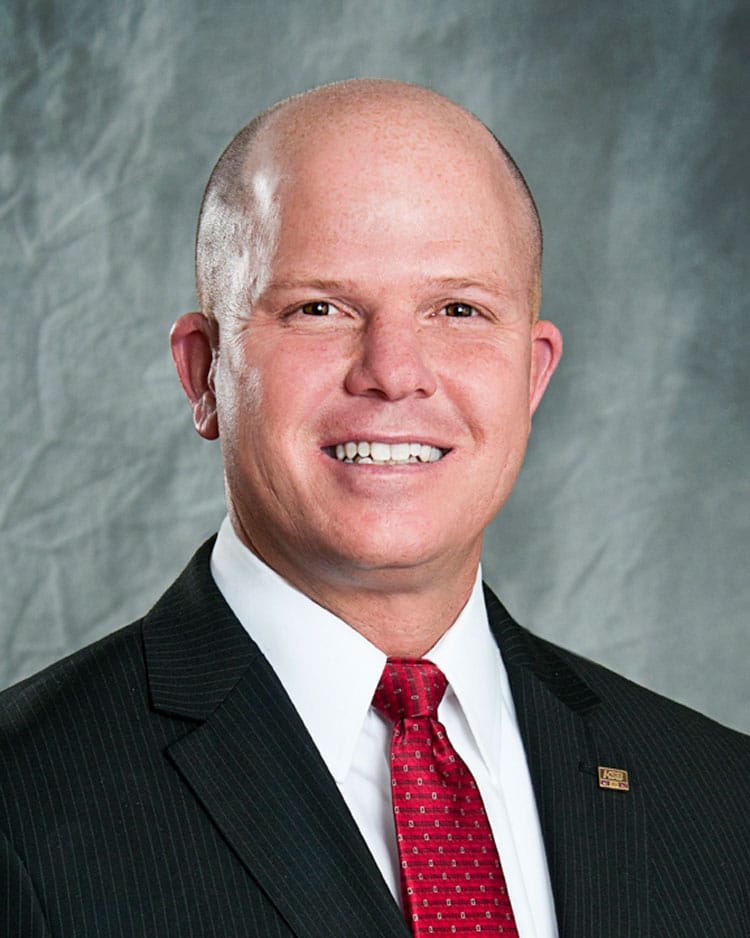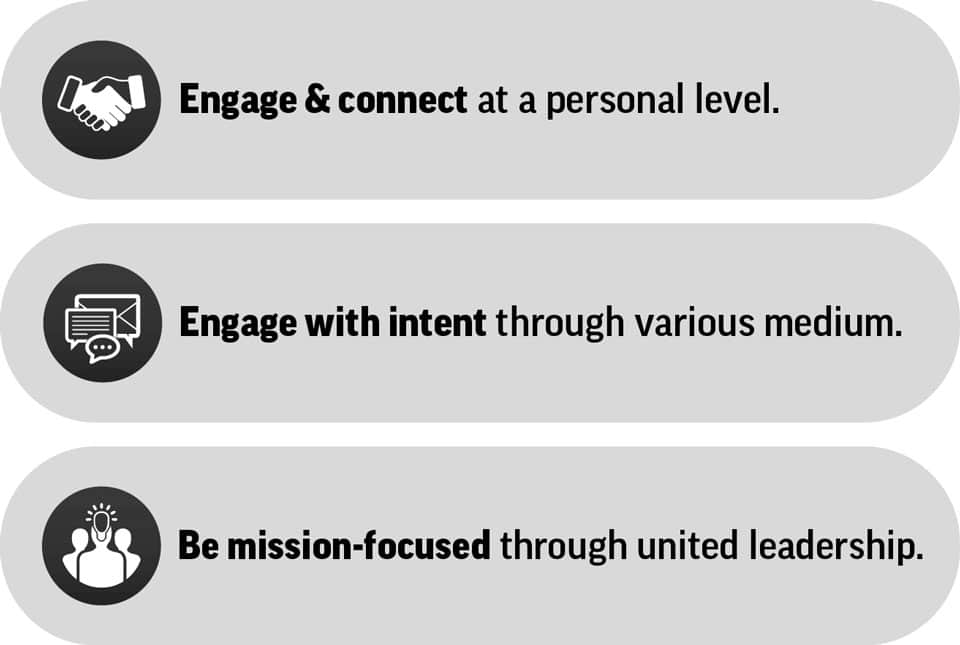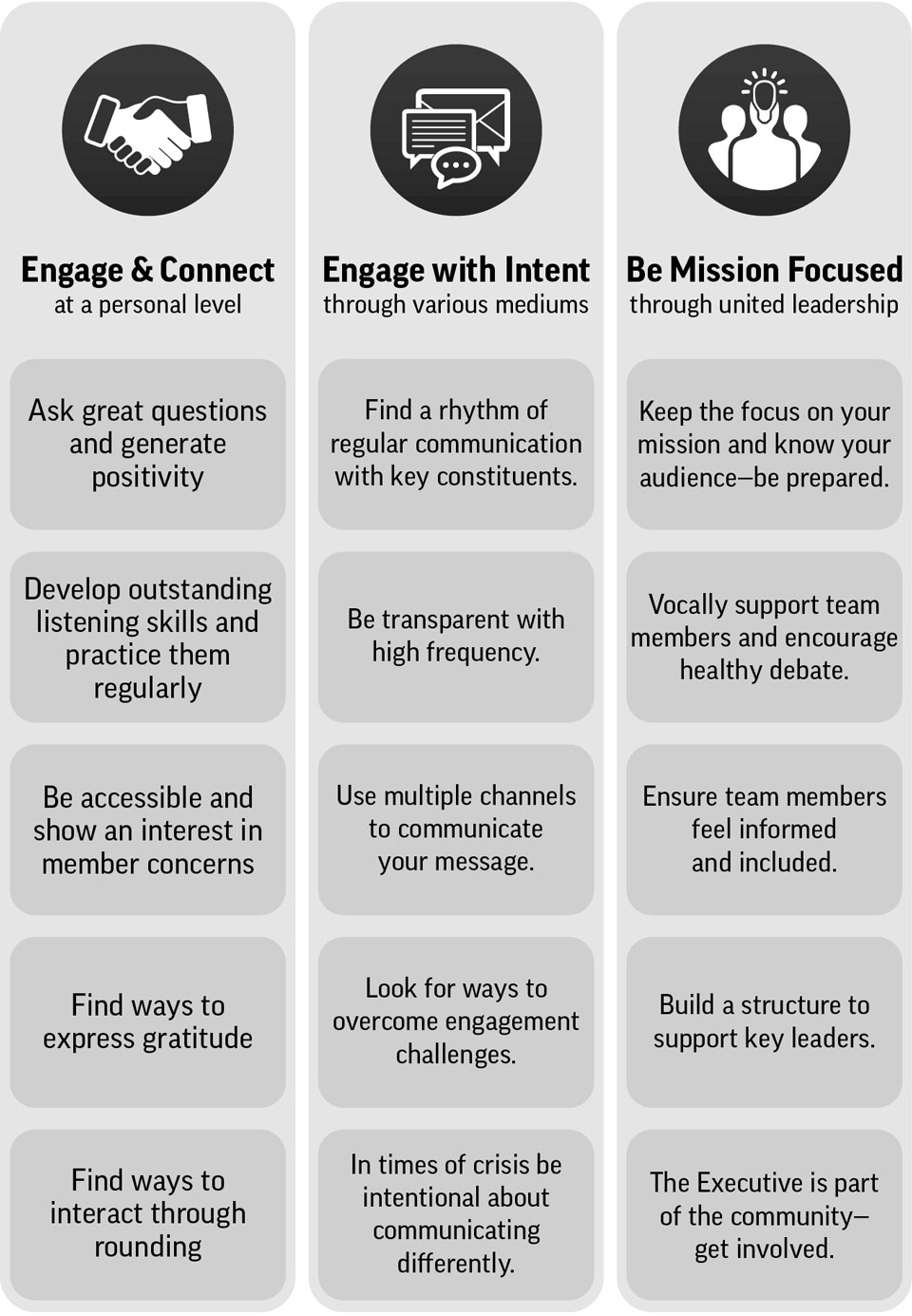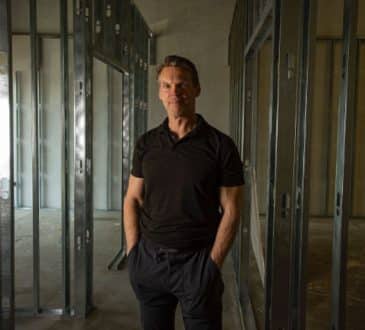Principles And Practices To Supercharge: Communications In Your Work Culture

The room grew quiet. All of the executive team members had shared their thoughts on the topic. The only person not to speak was the CEO.
“He always encourages us to speak first, and then, and only then, will he share his perspective”, says one of the vice presidents. “By going last, he chooses to not initially sway the discussion in a particular direction.”
While studying CEO engagement in five different hospitals from around the country, I found three engagement core principles, which are central to my supercharged communications concept. Each contains five practices that, when used in combination, resulted in increasing communication with the people that matter the most: the board chairman or owner, the people that report to us, and entry-level employees. These principles can be applied to any business in any industry.
The first supercharged engagement principle:
Engage and connect at a personal level
It’s easy for CEOs to get stuck in their office, dealing with various issues. That was me. But you’ve got to get out and connect with your people in order to supercharge your culture, and it starts with this principle.
The five practices for this principle:
- Ask great questions and generate positivity. The example above in the introduction is one of those practices taken from my first supercharged engagement principle. The same CEO typically asks great questions and generates positivity. He says, “Tell me more about your opinion on this topic. Help me to understand exactly where you are coming from, and tell me not only what your perspective is, but why you feel the way you do.”Specific, targeted, open-ended questions encourage team members to understand their perspectives at a deeper level and improve their ability to convey those opinions. Do you give people that report to you the freedom to express their opinions and understand those opinions are being heard?
- Develop outstanding listening skills and practice them regularly. Do you give people that report to you the freedom to express their opinions and understand those opinions are being heard? This practice generates positive engagement and increases the level of trust.
- Be accessible and show an interest in member concerns. Consider your personal standards of accessibility, and how you will listen and interact with your stakeholders. What can you do to show your people that you are invested in their concerns? Perhaps you cannot possibly respond to all your emails in a large company, but response time should still reflect your commitment to accessibility, whether that’s via an assistant or delegating the email to the proper department.
- Find ways to express gratitude. Regardless of the reasons someone works, we all like to be recognized for our efforts. But gratitude goes even beyond that. Gratitude is a mindset. You may think of gratitude as admiration for someone on your team: “I admire the way you thought about that and your unique perspective. Tell me more.” Gratitude should also involve recognition.
- Find ways to interact through rounding. Rounding is exactly what it sounds like – making rounds. In my case, I walk the hospital (and I also visit our satellite clinics, which entails driving to them off-site). You might walk the factory floor, or through various departments. In a large company you would obviously break it up, perhaps trying to get to each department once or twice a year, or once a quarter. But it’s important to be seen – this is about connecting. No more hiding in the office.
The second supercharged principle:
Engage with intent through various mediums
So often as leaders we assume engagement occurs when we hit the “send” button. We worked hard on crafting the message, right? What could possibly occur to minimize the level to which that message was heard?
The answer: Everything. Competing priorities for the recipient, bad timing, technological challenges, etc. Here are some ways to increase the chances of your message being received.
The five practices for this principle:
- Find a rhythm of regular communication with key constituents. Who is the intended audience? Are they expecting your communication because it comes out every Friday at noon, or is this a one-off message? Is the message easy to open and view on multiple devices? If the team members try initially without success, they may not give you a second bite at the apple to supercharge your message.
- Be transparent with high frequency. Not sure how much to share on a sensitive subject? Err on the side of sharing too much. That line of oversharing is rarely crossed.
- Use multiple channels to communicate your messages. Once upon a time, communication was fairly straightforward. That is not the case today. What I have discovered in my supercharged communications research is you need to use multiple channels. You need to meet your people and stakeholders where they are. Those channels include face-to-face (that includes Zoom), broadcast communications, mobile (including texts), phone, Slack and other instant messaging channels, social media, and of course email.
- Look for ways to overcome engagement challenges. Employee engagement is the connection an employee feels, both emotionally and mentally, to their team and their workplace/organization, as well as the work they do. Engaged employees demonstrate enthusiasm. They also are more productive and willing to go that extra mile. Be clear on the mission, communicate consistently and don’t overload or repeat information.
- In times of crisis be intentional about communicating differently. In crisis, it is important for nonessential communication to decrease for a time. Laser focus needs to be on the matter at hand. In order to communicate effectively in times of crisis, first, as a leader, you must identify your key messaging.
The third supercharged principle:
Be mission-focused through united leadership
Leadership – whether by parents or a board of directors or the C-Suite – must offer a united front and lead from that strength. United leadership builds trust from the workforce as the employees learn that all leaders in the company have a shared vision and everyone’s role is aligned with it.
The five practices for this principle:
- Keep your focus on the mission and know your audience – be prepared. As a hospital CEO I have learned that my message cannot be delivered in the same way to our medical staff and our housekeepers. Each group’s desire to understand specific items are different, and the amount of time one particular group is willing to allow me to share my message is highly variable. For example, while doctors may subscribe to the suggestion that time is money and sharing less is more, housekeepers are interested in different details that may influence their work, and they are willing to grant me more time.
- Vocally support team members and encourage healthy debate. Draw key people into the conversation with great questions, asked in a manner respectful of their interest and free time. Connect the topic of the moment to the organizational mission. When you have trust in your leadership and your teammates, disagreements come from a place of “How can we all do this better?” not accusations or resentments.
- Ensure team members feel informed and included. Leadership styles have evolved. Once upon a time, leadership was usually autocratic. It was a hierarchy, fairly linear, and top down.Now, leadership is more people-oriented and collaborative. We now expect leaders to be inclusive. Instead of barking orders or commands, we inform and use our soft skills, like supercharged communication, to pull people together into a cohesive team.
- Build a structure to support key leaders. Since I am in the healthcare arena, I look at it a bit like the cardiovascular system. Leadership starts at the heart of what we need to do, and then pumps the principles and actions through the entire corpus of the hospital.That structural model led to some amazing changes at our hospital. An employee engagement survey showed significant improvements in areas such as working well together as a team, being satisfied with the recognition they receive, different levels of the organization communicating effectively with each other, and feeling supported in work-life balance.
- The executive is part of the community – get involved. Many leaders are caught up in perception – how their employees perceive them. But I realized along the way that I didn’t need to be so concerned about how I present myself and what I have to say. It’s not about how the workplace community perceived me at all; it’s about me understanding what they have to say.Leaders, take note: As I have discovered, you don’t have to be interesting; rather, you have to be interested. That’s what executive involvement is – it’s relationship.
Getting involved means being a learner, connecting with the stakeholders and the people most important to you, and being open to what they share.
What if I told you that understanding these supercharged engagement principles and 15 practices will allow you to increase employee and patient engagement, leading to a higher return on investment and a more dedicated workforce?
Take a quick look through the 15 practices I mentioned. How many are you using today, both intentionally and as a matter of how you currently communicate? Commit to trying something different today. Your leadership and your work culture will be better for it.
Written by Dr. David L. Schreiner.
Have you read?
The World’s Most Influential CEOs And Business Executives Of 2023.
Which are the healthiest countries in the world for 2023?
Largest Hotel Chains in the World, 2023.
Report: Antigua and Barbuda Citizenship by Investment Programme, 2023.
International Financial Centers Ranking, 2023.
Best Citizenship by Investment (CBI) for 2023.
Add CEOWORLD magazine to your Google News feed.
Follow CEOWORLD magazine headlines on: Google News, LinkedIn, Twitter, and Facebook.
This report/news/ranking/statistics has been prepared only for general guidance on matters of interest and does not constitute professional advice. You should not act upon the information contained in this publication without obtaining specific professional advice. No representation or warranty (express or implied) is given as to the accuracy or completeness of the information contained in this publication, and, to the extent permitted by law, CEOWORLD magazine does not accept or assume any liability, responsibility or duty of care for any consequences of you or anyone else acting, or refraining to act, in reliance on the information contained in this publication or for any decision based on it.
Copyright 2024 The CEOWORLD magazine. All rights reserved. This material (and any extract from it) must not be copied, redistributed or placed on any website, without CEOWORLD magazine' prior written consent. For media queries, please contact: info@ceoworld.biz
SUBSCRIBE NEWSLETTER










